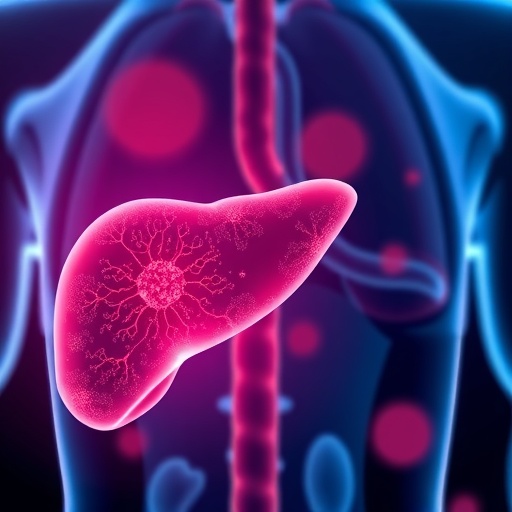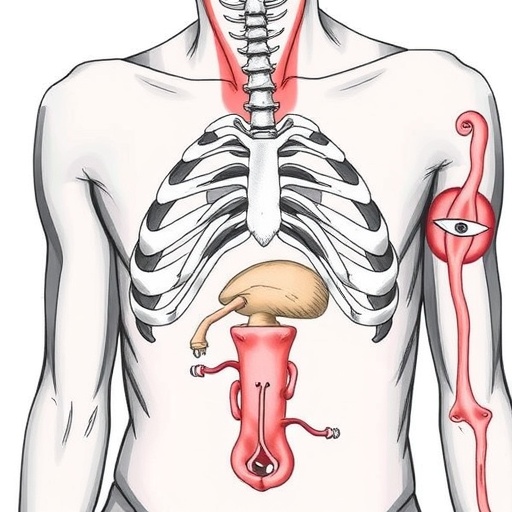Recent advancements in quantum chemical optimization have ushered in a new era for cancer therapeutics, particularly targeting hepatocellular carcinoma (HCC). A recent study led by researchers, including Foudah, A.I., Alqarni, M.H., and Aljarba, T.M., delves into the intricate mechanisms of Cyclin-Dependent Kinase 20 (CDK20) inhibitors. This innovative approach not only enhances our understanding of drug interactions at the molecular level but also offers a beacon of hope for developing more effective treatments for liver cancer, which remains one of the leading causes of cancer-related fatalities globally.
The significance of this study lies in its dual focus on quantum chemical optimization and residue-specific stabilization. Quantum chemical methods provide a sophisticated framework for predicting the binding interactions between drugs and their target proteins. By utilizing these powerful computational tools, the researchers aimed to refine the design of CDK20 inhibitors, ensuring that they bind more effectively to their target, thereby maximizing therapeutic efficacy while minimizing side effects.
At the molecular level, the study investigates the structural characteristics of CDK20 and its relevance in HCC. CDK20 plays a pivotal role in cellular proliferation, and its overactivation has been linked to various malignancies, including liver cancer. By honing in on the specific residues within the CDK20 structure that interact with inhibitors, the researchers have devised strategies to enhance drug binding affinity, which is crucial for effective tumor suppression.
The research teams employed a range of quantum mechanical methods, including density functional theory (DFT), to map out the electronic landscapes of both CDK20 and its potential inhibitors. This detailed analysis provided insights into the energetic profiles of various molecular conformations, ultimately guiding the optimization of these inhibitors. The ability to visualize and predict how minor structural changes can impact binding interactions is a game-changer in drug design.
An essential aspect of this research involves the incorporation of in silico simulations to validate the findings. The study didn’t just rely on computational predictions; it complemented these findings with experimental validation, underscoring the importance of integrating computational chemistry with empirical data. This holistic approach ensures that the designed inhibitors are not only theoretically potent but also practically viable and effective in biological settings.
Moreover, the researchers highlighted the specific residues on CDK20 that contribute to its interaction with inhibitors. By identifying key amino acids critical for binding, they crafted a roadmap for the design of next-generation inhibitors. The insights gained from residue-specific stabilization can facilitate the development of tailored therapeutics that adapt to the unique molecular architecture of different tumors, thereby enhancing precision medicine in oncology.
One of the major hurdles in traditional drug design is the high attrition rate in clinical trials, often stemming from poor efficacy or adverse side effects. By leveraging quantum chemical optimization, the researchers aim to reduce these risks significantly. The refined design processes not only streamline the development pipeline but also promise to produce candidates with improved therapeutic indices, ensuring patients receive drugs that effectively target their cancer while minimizing harm.
Additionally, hepatocellular carcinoma presents unique challenges due to its complex microenvironment and the presence of various aberrant signaling pathways. Understanding the molecular dynamics of CDK20 allows for a more nuanced approach to drug design, enabling researchers to anticipate potential resistance mechanisms that tumors might develop. Addressing the problem of drug resistance from the outset can lead to more robust treatment strategies, ultimately improving patient outcomes in HCC.
The global impact of this research cannot be understated, particularly as the incidence of liver cancer continues to rise. With increased rates of viral hepatitis and alcohol-related liver disease driving new cases, the need for effective therapeutics is urgent. Discoveries such as these exemplify how modern computational techniques can accelerate the discovery of promising candidates, potentially leading to breakthrough therapies that can save lives.
Furthermore, the integration of interdisciplinary approaches in cancer research can lead to synergistic innovations. By combining quantum chemistry with molecular biology, the researchers exemplify the potential of cooperative science in addressing complex medical challenges. It paves the way for aspiring scientists to think beyond traditional boundaries, encouraging the development of therapies that are not only scientifically sound but also clinically relevant.
As the study moves forward towards clinical applications, the ongoing dialogue between computational predictions and experimental validation will be crucial. Continuous iterations based on feedback from clinical outcomes will ensure that the solutions crafted are in tune with the realities of patient care. Future research could expand on these findings by exploring combination therapies that utilize CDK20 inhibitors alongside other modalities, such as immunotherapy, further enhancing treatment efficacy.
The implications of this study extend beyond hepatocellular carcinoma as well. The methodologies developed for the optimization of CDK20 inhibitors could be adapted to target other kinases implicated in various cancers, broadening the scope and impact of this research. This adaptability underscores the versatility of quantum chemical optimization as a pivotal tool in the arsenal against cancer and could lead to a new wave of therapeutics targeting multiple malignancies.
In conclusion, the intersection of quantum chemistry and cancer pharmacology represents a frontier filled with potential. The breakthroughs achieved in the optimization of CDK20 inhibitors signify a crucial step in the fight against hepatocellular carcinoma and underscore the transformative power of modern scientific approaches. As we look to the future, continued research in this domain promises to unveil innovative strategies that could redefine cancer treatment, ultimately leading to improved survival rates and better quality of life for patients worldwide.
With the landscape of cancer therapeutics constantly evolving, the work conducted by Foudah et al. serves as a reminder of the exciting possibilities that lie ahead. By harnessing the principles of quantum chemistry, the scientific community is well-positioned to tackle some of the most pressing challenges in oncology, fostering hope for patients and transforming the way we approach cancer treatment.
Subject of Research: Quantum chemical optimization and residue-specific stabilization of CDK20 inhibitors in hepatocellular carcinoma.
Article Title: Quantum chemical optimization and residue-specific stabilization of CDK20 inhibitors in hepatocellular carcinoma.
Article References:
Foudah, A.I., Alqarni, M.H., Aljarba, T.M. et al. Quantum chemical optimization and residue-specific stabilization of CDK20 inhibitors in hepatocellular carcinoma.
Mol Divers (2025). https://doi.org/10.1007/s11030-025-11339-8
Image Credits: AI Generated
DOI: 10.1007/s11030-025-11339-8
Keywords: Hepatocellular carcinoma, CDK20 inhibitors, quantum chemical optimization, molecular dynamics, precision medicine.
Tags: cancer-related fatalities and liver cancerCDK20 inhibitors for liver cancercomputational methods in cancer drug developmentdrug design for hepatocellular carcinomaenhancing therapeutic efficacy in liver cancerhepatocellular carcinoma treatment advancementsmolecular mechanisms of CDK20novel approaches to HCC therapyquantum chemical optimization in cancer therapyresidue-specific stabilization in drug interactionsstructural characteristics of CDK20targeting Cyclin-Dependent Kinases in cancer treatment





